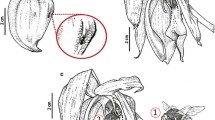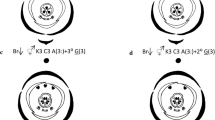Abstract
Iridaceae is one of the few families in which floral oils are produced and collected by pollinators as a resource. Perigonal nectaries and trichomal elaiophores are highly unusual within the tribe Sisyrinchieae. Both structures occur mainly on the staminal column, while they are usually distributed on the tepals in the other tribes of the subfamily Iridoideae. Sisyrinchieae is the largest tribe of Iridaceae present on the American continent, and the diversity observed may be related to the exceptional development of trichomal elaiophores within the genus Sisyrinchium, but knowledge concerning the other types of nuptial glandular structures within the tribe is still limited, preventing us from estimating their implication for species diversity. Structural observations and histochemical tests were performed to identify and characterize glandular structures and pollen rewards within the flowers of the genera Orthrosanthus, Sisyrinchium and Solenomelus. Perigonal nectaries were detected only in Solenomelus segethi, and trichomal elaiophores were characterized only within Sisyrinchium. All species showed large amounts of additional resources available for pollinators in the form of pollenkitt and polysaccharides present in the cytoplasm of the pollen grains. The results are discussed in a phylogenetic context, with regard to pollinators and floral rewards reported for the tribe Sisyrinchieae.






Similar content being viewed by others
References
Brundrett MC, Kendrick B, Peterson CA (1991) Efficient lipid staining in plant material with sudan red 7B or fluorol yellow 088 in polyethylene glycol glycerol. Biotech Histochem 66:111–116
Chauveau O, Eggers L, Raquin C et al (2011) Evolution of oil-producing trichomes in Sisyrinchium (Iridaceae): insights from the first comprehensive phylogenetic analysis of the genus. Ann Bot 107:1287–1312
Cholewa AF, Henderson DM (1984) Biosystematics of Sisyrinchium section Bermudiana (Iridaceae) of the Rocky Mountains. Brittonia 36:342–363
Cocucci AA, Vogel S (2001) Oil-producing flowers of Sisyrinchium species (Iridaceae) and their pollinators in southern South America. Flora 196:26–46
Cocucci AA, Sérsic A, Roig-Alsina A (2000) Oil-collecting structures in Tapinotaspidini: their diversity, function and probable origin. Mitt Münch Entomol Ges 90:51–74
Diaz G, Melis M, Batetta B, Angius F, Falchi AM (2008) Hydrophobic characterization of intracellular lipids in situ by Nile Red red/yellow emission ratio. Micron 39:819–824
Dobson HEM (1987) Role of flower and pollen aromas in host-plant recognition by solitary bees. Oecologia 72:618–623
Dobson HEM (1988) Survey of pollen and pollenkitt lipids—chemical cues to flower visitors? Am J Bot 75:170–182
Forcone A, Galetto L, Bernardello L (1997) Floral nectar chemical composition of some species from Patagonia. Biochem Syst Ecol 25(5):395–402
Gerrits PO, Smid L (1983) A new, less toxic polymerization system for the embedding of soft tissues in glycol methacrylate and subsequent preparing of serial sections. J Microsc 132:81–85
Goldblatt P, Manning JC (2006) Radiation of pollination systems in the Iridaceae of sub-Saharan Africa. Ann Bot 97:317–344
Goldblatt P, Manning JC (2008) The Iris family—natural history and classification. Timber Press, Portland
Goldblatt P, Rodriguez A, Powell MP et al (2008) Iridaceae ‘Out of Australasia’? Phylogeny, biogeography, and divergence time based on plastid DNA sequences. Syst Bot 33:495–508
Greenspan P, Mayer EP, Fowler SD (1985) Nile Red: a selective fluorescent stain for intracellular lipids droplets. J Cell Biol 100:965–973
Henderson DM (1976) A biosystematic study of Pacific Northwestern blue-eyed grasses (Sisyrinchium, Iridaceae). Brittonia 28:149–176
Hesse M (1979a) Development and ultrastructure of the exine and the sticky substance of the pollen in closely related entomophilous and anemophilous angiosperms: salicaceae, Tiliaceae and Ericaceae [German]. Flora 168:540–557
Hesse M (1979b) Development and ultrastructure of the exine and sticky substance of the pollen in closely related entomophilous and anemophilous angiosperms: polyganaceae [German]. Flora 168:558–577
Hesse M (1979c) Ultrastructure and distribution of pollenkitt in insect- and wind-pollinated Acer. [German]. Plant Syst Evol 131:277–289
Johansen DA (1940) Plant microtechnique. McGraw-Hill, USA
Machado IC (2004) Oil-collecting bees and related plants: a review of the studies in the last twenty years and case histories of plants occurring in NE Brazil. In: Freitas B, Pereira JOP (eds) Solitary bees, conservation, rearing and management for pollination. Editora Universitária, Fortaleza, pp 255–280
McDowell EM, Trump BF (1976) Histologic fixatives suitable for diagnostic light and electron microscopy. Arch Pathol Lab Med 100:405–414
Mercer EH (1963) A scheme for section staining in electron microscopy. J Roy Microsc Soc 81:179–186
Michener CD (2007) The bees of the world. Johns Hopkins University Press, Baltimore
Montgomery BR (2009) Pollination of Sisyrinchium campestre (Iridaceae) in prairies invaded by the introduced plant Euphorbia esula (Euphorbiaceae). The Am Midl Nat 162:239–252
O’Brien TP, McCully ME (1981) The study of plant structure principles and selected methods. Termarcarphi Pty Ltd., Australia
Pacek A, Stpiczyńska M (2007) The structure of elaiophores in Oncidium cheirophorum Rchb.f. and Ornithocephalus kruegeri Rchb.f. (Orchidaceae). Acta Agron 60:9–14
Pacini E, Hesse M (2005) Pollenkitt—its composition, forms and functions. Flora 200:399–415
Pacini E, Guarnieri M, Nepi M (2006) Pollen carbohydrates and water content during development, presentation, and dispersal: a short review. Protoplasma 228:73–77
Renner SS, Schaefer H (2010) The evolution and loss of oil-offering flowers: new insights from dated phylogenies for angiosperms and bees. Philos T Roy Soc B 365:423–435
Roig-Alsina A (1997) A generic study of the bees of the tribe Tapinotaspidini, with notes on the evolution of their oil-collecting structures. Mitt Münch Entomol Ges 87:3–21
Roulston TH, Cane JH (2000) Pollen nutritional content and digestibility for animals. Plant Syst Evol 222:187–209
Rudall PJ, Manning JC, Goldblatt P (2003) Evolution of floral nectaries in Iridaceae. Ann Mo Bot Gard 90:613–631
Truylio B, Harter-Marques B, Engels W (2002) Biologia floral e polinização de Sisyrinchium micranthum (Iridaceae) na região do planalto das araucarias do Rio Grande do Sul, Brasil. Biociências 10:11–24
Vogel S (1974) Ölblumen und ölsammelnde Bienen. Abhandlungen Akademie Wissenschaften Mathematisch-Naturwissenschaften Klasse. Tropische und Subtropische Pflanzenwelt 7:1–267
Acknowledgments
The authors are grateful to M.N. Soler and S. Brown (IFR87) for their continuous help during the light microscope studies, and to Celine Charon (Institut de Biologie des Plantes—Université Paris Sud—UMR 8618) and Juliana Troleis (Laboratório de Anatomia Vegetal “LAVeg”—Universidade Federal do Rio Grande do Sul) for additional supports. This work has benefited from the facilities and expertise of the Imagif Cell Biology Unit of the Gif campus (http://www.imagif.cnrs.fr/), which is supported by the Conseil Général de l’Essonne and received funding from the French/Brazilian CAPES/COFECUB cooperation project Sv550/07 and from the IFR87 ‘La plante et son environnement’. The first author was sponsored by a CAPES scholarship (process 3703/09-6).
Author information
Authors and Affiliations
Corresponding author
Additional information
Communicated by Scott Russell.
Rights and permissions
About this article
Cite this article
Silvério, A., Nadot, S., Souza-Chies, T.T. et al. Floral rewards in the tribe Sisyrinchieae (Iridaceae): oil as an alternative to pollen and nectar?. Sex Plant Reprod 25, 267–279 (2012). https://doi.org/10.1007/s00497-012-0196-1
Received:
Accepted:
Published:
Issue Date:
DOI: https://doi.org/10.1007/s00497-012-0196-1




